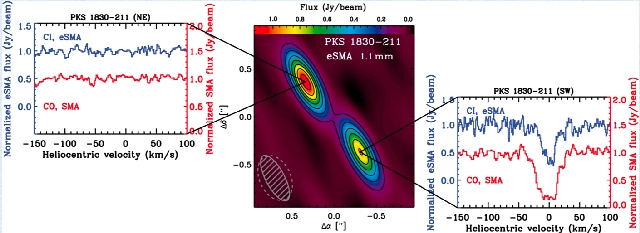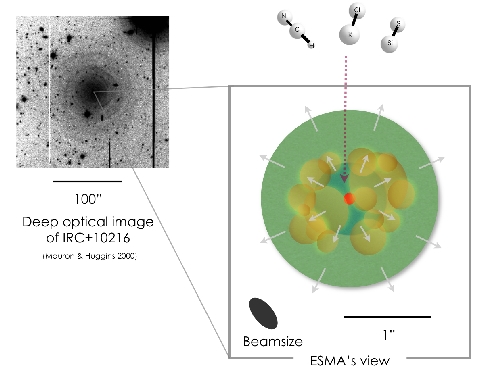
 Initial
Science Results from the Extended Submillimeter Array (eSMA).
Initial
Science Results from the Extended Submillimeter Array (eSMA).

As we reported
in our
previous news, the Extended Submillimeter Array, named "eSMA", is
a special
interferometer that combines the signals from the Submillimeter Array (SMA),
which consists of eight 6-m
diameter dishes, the 15-m
James Clerk
Maxwell Telescope (JCMT), and the 10.4-m Leighton Telescope
at the Caltech
Submillimeter
Observatory thtough fiber optics cables. Comparing with
the SMA alone,
the eSMA
doubles the collecting area and improves about twice better spatial
resolution. There was
a
special opening event in November 2008 to celebrate that the eSMA
is ready to carry out science observations.
There have been two initial science results done with the
eSMA. One of the initial studies using the eSMA, led by
Dr. Sandrine Bottinelli from Leiden Observatory, was to observe a
distant bright quasar after being gravitationally
focused by an intervening spiral galaxy called PKS1830-211. With
the improved sensitivity and spatial resolution,
astronomers were able
to study the nature of atomic/molecular gas associated with a spiral
galaxy at the redshift z
of 0.89 (Figure
1) located in front of the bright quasar. The spiral galaxy is
located when the Universe was only
45 % of its current age. The result was reported in the
Astrophysical Journal Letters (Bottinelli et
al. 2009).
The other initial study was of a nearby evolved star, IRC+10216
(Figure 2). The star has a mass
similar to the Sun and is close to the end of its life. During
this phase a star expels a lot of the gas in its outer
layers to form an envelope and, by tracing the hydrogen cyanide
molecule (HCN), the eSMA observed for the
first time in detail the zone where molecules form from the gas and are
being accelerated away from the
star (Shinnaga
et
al. 2009).

Figure 1.
Continuum image of the distant quasar and atomic carbon (CI) spectra
and
carbon monoxide (CO) of the intervening galaxy observed by the eSMA.
The color scale shows the
two artifact images of the distant quasar produced by the gravitational
lensing. Absorption by atomic
carbon and carbon monoxide are present in the spectrum observed towards
the southwest image,
indicated that the deflected light actually goes through a molecular
cloud located in an arm of the
spiral. (Credits: S. Bottinelli, A. M. Hughes)

Figure 2. The
picture shows a concept of the observational results on a nearby
Sun-like star IRC+10216.
The picture at the top left shows a deep optical image of the star,
IRC+10216, taken with the Canada-France-
Hawaii telescope. At the end of its life as a sun-like star, IRC+10216
is shedding its outer layers, visible as shells
in the picture which obscure the image of the central region in optical
light. At millimetre and submillimetre
wavelengths the eSMA can penetrate the shells and with its high
resolution study the inner envelope of the
star in detail, as shown in the artist rendering on the bottom-right.
IRC+10216 itself is represented by the red
circle at the center. Several hundred million miles above the star's
surface, shown as the darker green region,
the temperature of the expelled material becomes low enough for dust
and molecules to form. Light from the star,
which is thousands of times more luminous than our sun, accelerates the
dust and gaseous molecular material
(such as HCN, KCl, and SiS). Outside of this innermost portion of the
dusty envelope, the material reaches a
high velocity and is found to have a clumpy distribution, illustrated
here as yellow blobs. These eSMA observations
are the first time that this acceleration region was spatially resolved
and the kinematics could be studied in detail.
(Credits: H. Shinnaga)
Go back to A Digest of Recent News and
Scientific Results at the Caltech Submillimeter Observatory

 Initial
Science Results from the Extended Submillimeter Array (eSMA).
Initial
Science Results from the Extended Submillimeter Array (eSMA).


 Initial
Science Results from the Extended Submillimeter Array (eSMA).
Initial
Science Results from the Extended Submillimeter Array (eSMA).


